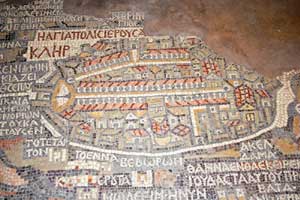Madaba, Jordan
Madaba is a capital city of Madaba Governorate of
Jordan, which has a population of about 60.000. Madaba is
the fifth most populous town in Jordan. It is best known for
its Byzantine and Umayyad mosaics, especially a large Byzantine-era
mosaic map of Palestine and the Nile delta. Madaba is located
30 miles south-west of the capital Amman.
 |
| A 6th century mosaic map of Jerusalem |
History
Madaba has a very long history stretching from the
Neolithic period. The town of Madaba was once a Moabite border
city, mentioned in the Bible in Numbers 21:30 and Joshua 13:9,
Madaba dates from the Middle Bronze Age.
During its rule by the Roman and Byzantine Empires
from the second to the seventh centuries AD, the city formed
part of the Provincia Arabia set up by the Roman Emperor Trajan
to replace the Nabataean kingdom of Petra. During the rule
of the Islamic Umayyad Caliphate, it was part of the southern
Jund of Palestine.
The first witness of a Christian community in the
city, with its own bishop, is found in the Acts of the Council
of Chalcedon in 451, wherein Constantine, Metropolitan Archbishop
of Bostra, the provincial capital, signed on behalf of Gaiano,
"Bishop of the Medabeni."
The re-settling of the city ruins by 90 Arab Christian
families from Kerak, in the south, led by two Italian priests
from the Latin Patriarchate of Jerusalem in 1880, saw the
start of archaeological research. This in turn supplemented
substantially the scanty documentation available.
 |
| Madaba
Church |
Religion in Madaba
Jordanian Christians constitute about 35-40% of the city's population. Madaba contains important Christian religious sites and churches.
Archaelogical finds in Madaba city
The first mosaics were discovered, purely by chance,
during the building of the new permanent dwellings using squared-up
stones from the old monuments. The new inhabitants of Madaba,
made conscious of the importance of the mosaics by their priests,
made sure that they took care of and preserved all the mosaics
that came to light.
The mosaic Map of Madaba was discovered in 1896;
the findings were published a year later. This discovery drew
the city to the attention of scholars worldwide. It also positively
influenced the inhabitants who shared the contagious passion
of F. Giuseppe Manfredi to whose efforts we owe the discovery
of most of the mosaics in the city. Madaba became the "City
of Mosaics" in Jordan.
The northern part of the city turned out to be the
area containing the greatest concentration of mosaic monuments.
During the Byzantine-Umayyad period, this northern area, crossed
by a colonnaded Roman road, saw the building of the Church
of the Map, the Hippolytus Mansion, the Church of the Virgin
Mary, the Church of Prophet Elijah with its crypt, the Church
of the Holy Martyrs (Al-Khadir), the Burnt Palace and the
Church of the Sunna' family.
The Madaba Mosaic Map is an index map of the region,
dating from the sixth century CE, preserved in the floor of
the Greek Orthodox Basilica of Saint George. With two million
pieces of colored stone, the map depicts hills and valleys,
villages and towns in Palestine and the Nile Delta. The mosaic
contains the earliest extant representation of Byzantine Jerusalem,
labeled the "Holy City." The map provides important details
as to its 6th century landmarks, with the cardo, or central
colonnaded street and the Holy Sepulchre clear visible. This
map is one key in developing scholarly knowledge about the
physical layout of Jerusalem after its destruction and rebuilding
in AD 70.
Other mosaic masterpieces found in the church of
the Virgin and the Apostles and the Archaeological Museum,
depict a profusion of flowers and plants, birds and fish,
animals and exotic beasts, as well as scenes from mythology
and everyday pursuits of hunting, fishing and farming. Hundred
of other mosaics from the 5th through the 7th centuries are
scattered throughout Madaba's.